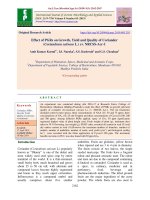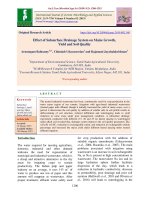Effect of ohmic heating on quality and storability of sugarcane juice
Bạn đang xem bản rút gọn của tài liệu. Xem và tải ngay bản đầy đủ của tài liệu tại đây (616.84 KB, 13 trang )
Int.J.Curr.Microbiol.App.Sci (2018) 7(1): 2856-2868
International Journal of Current Microbiology and Applied Sciences
ISSN: 2319-7706 Volume 7 Number 01 (2018)
Journal homepage:
Original Research Article
/>
Effect of Ohmic Heating on Quality and Storability of Sugarcane Juice
P. Abhilasha* and U.S. Pal
Department of Argil. Processing and Food Engineering, College of Agricultural Engineering
& Technology, Orissa University of Agriculture and Technology, Bhubaneswar, Orissa, India
*Corresponding author
ABSTRACT
Keywords
Sugarcane, Ohmic
heating, Storability,
Conventional Heating,
Quality
Article Info
Accepted:
20 December 2017
Available Online:
10 January 2018
Sugarcane juice was analysed for the two different treatments such as
ohmic heating and conventional heating. The study analysis showed that
the total plate count decreased with severity of ohmic heating treatment
which reduced from 6.3 to 3.47 log cfu/ml for 90 C and 15 min treatment.
So observing the PPO inactivation, colour change and microbial reduction
of the treated samples into consideration, ohmic heating of sugarcane juice
at 70C for 3 min holding time was found to be optimum. Hence, highest
microbial reduction was observed in ohmic heating treatment than
conventional heating treatment.
Introduction
Sugarcane (Saccharum officinarum) is one of
the most widely relished beverages of south
Asia. It is also known as noble cane, due to its
high sucrose content and low fiber content is
important in industrial crops of the world.
Enzymatic browning is one of the major
causes for deleterious changes in the sensory
properties of the product thereby limiting its
storage for a longer time (Bucheliand
Robinson, 1994). Sugarcane juice has been
used in the Ayurveda and Unani systems of
medicine in India, since time immemorial.
Sugarcane extract has displayed a wide range
of biological effects including immune
stimulation (El-Abasy et al., 2002), anti-
thrombosis
activity,
anti-inflammatory
activity, vaccine adjuvant, modulation of
acetylcholine release (Barocci et al., 1999).
Conventional heat processing imparts the taste
of jaggery and the delicate flavor of juice is
adversely affected. Polyphenol oxidase is the
major enzyme involved in the discoloration of
sugarcane juice which can be improved by
heat inactivation of enzyme. Addition of citric
acid or ascorbic acid to juice also gave good
pleasant dull orange colour to juice. Addition
of lemon and ginger followed by
pasteurization and preservation with sulphur
dioxide also reduced physico-chemical
changes during storage of ready-to-serve
bottled sugarcane juice. However enzymatic
2856
Int.J.Curr.Microbiol.App.Sci (2018) 7(1): 2856-2868
browning and spoilage by microorganisms due
to the presence of simple sugar after extraction
are responsible for its short shelf life. Ohmic
heating (OH) has gained wide popularity as an
alternative thermal treatment as it causes
volumetric heating of the sample which leads
to consistent and rapid heat generation
especially in liquid foods. The rate of heat
generation in OH is a function of electric field
strength applied across the food material
(Ramaswamy,
Marcotte,
Sastry,
and
Abdelrahim, 2014). Due to short processing
times, OH causes minimum discoloration and
maintains the nutritive value of the food
(Leizerson and Shimoni, 2005; Wang and
Sastry, 2002). This feature makes it one of the
most desirable treatments particularly for
sugarcane juice; as it contains sensitive flavor
components that are easily destroyed at longer
treatment times.
for 5, 10 and 15 min), A volume of 50 ml of
juice was taken in a beaker and placed in lab
scale water bath maintained at the desired
temperature (Fig. 1). After the desired
temperature of juice was achieved, it was held
at that temperature for the desired time
duration fresh sugarcane juice was taken as
control. Three alternated replicates were
conducted for each condition. The treated
samples are analysed for PPO inactivation,
physio-chemical, microbial and sensory
attributes. All the lots of juices were filled and
stored in sterilized HDPE bottle for 20 days at
refrigeration temperature (40C). The samples
were drawn and analyzed for physicochemical, microbiological and sensory
attributes at an interval of 5 days.
Ohmic heating
Development of ohmic heating set up
Materials and Methods
Preparation of sugarcane juice
Fully mature sugarcane stems were procured
from the local market of Bhubaneswar. Fresh
sugarcane was used for the extraction of
sugarcane juice. Sugarcane stems were then
washed by running tap water to get sugarcane
free from any dust and dirt. The stems were
peeled and manually cut into small pieces with
the help of stainless steel knife. Sugarcane
juice were extracted by motor grinder (Make:
Krishna) and filtered through the sieve and
muslin cloth to remove the extraneous
matterandobtain a clear filtrate which was
used for the study.
Application
techniques
of
different
preservation
Conventional heating
Different lots of sugarcane juices were
subjected to pasteurization (at 70, 80 and 90oC
Four ohmic heating set up were developed for
treatment of the sugarcane juice. Rectangular
chambers were fabricated from perplex sheet
with different length to obtain different
electrical field strengths of 16, 32, 48 and 64
V/cm. Two stainless steel flat (100x50x5 mm)
were used as electrodes and inserted in the
groove located at the two ends of the
rectangular chamber. The distance between
the electrodes were maintained at 14.4, 7.2,
4.8 and 3.6 cm to obtain electrical field
strengths of 16, 32, 48 and 64 V/cm. A power
supply of 230 V and 50 Hz was used to carry
out the experiment.
Ohmic heating of sugarcane juice
The ohmic heating of sugarcane juice was
carried out at four different electric field
strengths and the temperature rise with heating
time was recorded. The best set up was used
for further ohmic heating study. The sample
was placed in the chamber and connected to
the electrical circuit. A digital temperature
2857
Int.J.Curr.Microbiol.App.Sci (2018) 7(1): 2856-2868
indicator was was used to record and maintain
the temperature of the sugarcane juice during
treatment. The samples were heated and held
at 70, 80 and 90oC for 1, 2 and 3 min holding
time during ohmic heating (Fig. 2).
The heating time, holding time and total
processing time is given in Table 1. The
samples were stored in sterilized HDPE bottle
for further analysis.
Where Absample is the sample absorbance;
Abblank is the blank absorbance; and t the
incubation time of sample with reagents (min).
The activity of the samples was expressed as
% Residual PPO Activity (RA) as given in Eq.
(2):
Current Enzyme Activity
% RA = ------------------------------- × 100 (2)
Initial Enzyme Activity
Storage study
Physicochemical tests
Samples processed by different treatments
were packed in sterile HDPE bottle and stored
under refrigerated conditions of storage for 20
days. The physico-chemical and microbial
parameters of the stored sugarcane juice were
conducted at 5 days storage interval for
assessment of shelf life by different
preservation techniques.
Physico-chemical parameters such as Hunter
colour value, total soluble solid (TSS), titrable
acidity, reducing sugar content of treated
sugarcane juice were performed as determined
by AOAC International (AOAC, 2007).
TSS
The total soluble solids content of sugarcane
juice (expressed as °Brix) was determined
using portable digital refractometer (Make:
ATAGO. Model: REF113).
Determination of quality parameters
Polyphenol oxidase (PPO) enzyme assay
The assay of the enzyme was carried out as
described by Ozoglu and Bayindirli (2002).
One ml of 0.2 mol/L Catechol solution was
added to mixture of 0.5 ml of sugarcane juice
and 2 ml of phosphate buffer (pH 6.5). The
absorbance was measured at 420 nm at every
1 min interval by spectrophotometer (Make:
Systronics; Model: 106). The enzyme activity
was estimated from the linear portion of the
curve of absorbance v/s time. One unit of PPO
activity was defined as 0.001A420/min.
Enzyme activity was expressed in U/mL with
one unit equivalent to a variation of 0.001
absorbance per minute per mL of sample. The
equation 1 was applied to calculate the
enzyme activity:
Measurement of color
Colour of the sugarcane juice samples was
measured by colour reader CR-20 (Konica
Minolta, INC, Japan). Colorimeter was
calibrated using white control sample
Coordinates ‘L’ represented the lightness of
color (0 = black; 100 = white), −a/+a
greenness or redness, and −b/+b blueness or
yellowness. Samples were kept in petri plates
and colour value of L, a and b was measured.
For each sample, three measurements were
taken and averaged. The total color change
(ΔE) was calculated using Eq 3 (Altan et al.,
2008). L0, a0 and b0 are the colour values of
control sample.
(3)
2858
Int.J.Curr.Microbiol.App.Sci (2018) 7(1): 2856-2868
Titrable acidity
The titratable acidity (expressed as % citric
acid) was determined by titration with 0.1 N
NaOH. It was determined by quantifying the
volume of 0.01N NaOH required to raise the
pH value to 8.3, and expressed as ml of 0.01
M NaOH per 10 ml of juice. About 10mlof
sample was Pipette in to a 250 ml conical
flask. It was added about 50ml of distilled
water and few drops of phenopthalin indicator
in to the conical flask. It was Titrated against
to the 0.1 N NaOH up to light pink end point
with solution product (Fig. 3).
Eq. wt. of acid× Titre value ×
Normality of NaOH
Acidity, % = ------------------------------- (4)
10× vol. of sample taken
(PDA). TPC and YMC were counted in series
dilution method. Results were expressed as
colony forming units per milliliter.
The unit for calculation is CFU= (Number of
colony ×dilution factor)/volume plated in mL
Sensory tests
Sensory evaluation of sugarcane juice
processed by different treatments was carried
out, using a nine-point hedonic scale, as
described by Dutcosky (2013). The attributes
like colour, flavour and taste were evaluated
by 10 panelists and consumers. The juice was
served at a temperature of about 12°C. The
overall acceptability of sugarcane juice was
calculated by composite scoring giving 40, 20
and 40% weightage to colour, flavour and
taste score.
Reducing sugar content
Statistical analysis
Reducing sugar content was determination by
DNS (Dinitro salicylic Acid) method. About
0.5 ml of the sample was taken in a test tube
and the volume was equalized to 3ml with
distilled water. 3ml of DNS reagent was added
to it. Then the contents in the test-tube were
heated in a boiling water bath for 5mins.
When the contents of the tubes were still
warm, 1ml of 40% Rochelle salt solution was
added to it. It was cooled and the absorbance
reading was taken at 510 nm. A series of
standards was prepared using glucose (0500mg) and plot a graph. The amount of
reducing sugar present in the sample was
determined from the standard curve.
Microbiological tests
The sugarcane juice samples was analysed for
their commercial sterility. Total Plate Count
(TPC) was determined using Nutrient Agar
(NA) after incubation, and for 48 h at 30oC.
Yeast and molds (YMC) were estimated with
the help of acidified potato dextrose agar
The experimental data were analysed by
Analysis of variance (ANOVA) using MS
EXCEL 2007at 5% confidence level for
comparison.
Results and Discussion
Effect of different treatments on quality of
sugarcane juice
Conventional heating
The effect of different processing temperature
and treatment time on residual PPO activity
(% RA), colour change, titrable acidiy,
reducing sugar content, TSS and total plate
count during conventional heating is shown in
Table 2. It was observed that residual PPO
activity decreased with increase in processing
temperature and time (p< 0.05). Highest
residual PPO activity was observed at 700 C
for 5 min, whereas it was found to be less at
higher processing temperature of 900C.
2859
Int.J.Curr.Microbiol.App.Sci (2018) 7(1): 2856-2868
However, no significant difference (p < 0.05)
was found in the RA of the enzyme at 80oC
for 10 and 15 min treatment and 90oC for all
the time treatment suggesting the development
of resistance of the enzyme to inactivation
after prolonged exposure to high temperature
which had also been reported by Terefe et al.,
(2010).
Further, the change in colour was more at
higher processing temperature and longer
treatment time probably due to non-enzymatic
browning during thermal treatment. It was
observed that reducing sugar content increased
significantly (p<0.05) with processing
temperature and time. This might be due to the
inversion of sugar which resulted in higher
reducing sugar content leading to poor
keeping quality of the juice. The TA of
samples was not changing significantly and
the slight increase may be attributed to some
biochemical processes that might have been
accelerated by the treatment. The increase in
TSS was observed with heating temperature
and time probably due to evaporation of water
due to heat treatment. The total plate count
decreased with severity of thermal treatment
which reduced from 6.3 to 3.45 log cfu/ml at
90oC and 15 min treatment.
So keeping PPO inactivation, colour change,
reducing sugar content and microbial
reduction of the treated samples into
consideration, it was recommended for
conventional heating of sugarcane juice at 80
0
C for 10 min.
Ohmic heating
Effect of field strength on temperature rise
The temperature rise of sugarcane juice during
ohmic heating at four electrical field strength
is shown in Table 3. It was observed that
temperature rise was slow at 16 and 32 V/cm
and steady at 64 V/cm. The juice temperature
attained 90oC at 5, 15 and 36 min when
exposed to ohmic heating at 64, 48 and 32
V/cm, respectively. Frothing of juice occurred
during ohmic heating at 64 V/cm with
instantaneous temperature rise and it was
difficult to control. The low heating rate at 16
and 32 V/cm, resulted in prolonged treatment
time which was not desirable due to quality
loss. So, it was decided to conduct the ohmic
heating of sugarcane juice at electrical field
strength of 48 V/cm. Castro et al., (2004)
reported increase in enzymatic activity when
exposed to low electric field strengths due to
changes in the molecular spacing that
accelerated the inter-chain biochemical
reactions and suggested the possible use of
higher electric field strength of 48 V/cm
during ohmic heating.
Effect processing conditions on quality of
sugarcane juice
The effect of different processing temperature
and time on residual PPO activity (% RA),
colour change, titrable acidiy, reducing sugar
content, TSS and total plate count during
ohmic heating of sugarcane juice with 48
V/cm field strength is shown in Table 4. It was
observed that residual PPO activity decreased
significantly (p<0.05) with increase in
treatment temperature and processing time
during ohmic heating.
The residual PPO activity was less with less
colour change in ohmic heated samples treated
with 700 C for 3 min holding time. At higher
temperature and holding time the colour
change was observed to be more. The
reducing sugar and titrable acidity were not
changing significantly and the slight increase
may be attributed to some biochemical
processes that might have been accelerated by
the treatment. The TSS increased with
processing temperature which might be due to
evaporation of water by thermal effect during
ohmic heating.
2860
Int.J.Curr.Microbiol.App.Sci (2018) 7(1): 2856-2868
Table.1 Heating time, holding time and total processing time during conventional and ohmic
heating treatment
Temperature, oC
Conventional heating
70
80
90
Ohmic heating
70
80
90
Heating time
(min)
Holding time
(min)
Total processing time
(min)
10
12
14
5, 10, 15
5, 10, 15
5, 10, 15
15, 20, 25
17, 22, 27
19, 24, 29
12
13.5
15
1, 2, 3
1, 2, 3
1, 2, 3
13, 14, 15
13.5, 15.5, 16.5
16,17,18
Table.2 Physico-chemical and microbial properties of sugarcane juice treated with conventional
heating at different temperature and time
Temperature, 0C
70
80
90
Holding
time
(min)
5
10
15
5
10
15
5
10
15
Control
RA%
Colour
change
58.9±4.1
55.3±3.8
50.1±3.6
51.6±3.6
42.2±3.2
40.1±2.8
38.3±2.5
38.0±2.2
35.7±2.1
3.5±0.2
3.9±0.2
4.2±0.3
4.2±033
4.6±0.4
6.2±0.41
8.5±0.45
9.1±0.43
10.8±0.5
Titrable
acidity
(g/100ml)
0.132±0.003
0.136±0.004
0.136±0.004
0.136±0.004
0.132±0.003
0.131±0.002
0.140±0.004
0.136±0.005
0.132±0.003
0.130
Reducing
sugar
(g/100 ml)
0.482±0.005
0.479±0.004
0.475±0.003
0.483±0.005
0.490±0.006
0.524±0.007
0.569±0.008
0.572±0.009
0.592±0.009
0.460
TSS
(0 Brix)
TPC
(log cfu/ml)
18.7±0.3
19.4±0.3
20.7±0.3
19.6±0.3
20.6±0.4
21.9±0.4
20.5±0.4
21.4±0.5
22.7±0.5
18.1
6.13±0.09
5.57±0.06
5.04±0.04
6.08±0.07
5.01±0.05
4.81±0.04
5.92±0.08
4.34±0.04
3.45±0.04
6.30
Table.3 Temperature profile of sugarcane juice at different electrical field strength
Time (min)
5
10
15
20
25
30
35
36
40
45
50
55
60
65
Electric field strength, V/cm
16
32
27
40
28
44
39
52
41
57
45
67
49
75
52
88
54
90
57
59
62
65
67
70
2861
48
41
53
90
64
90
Int.J.Curr.Microbiol.App.Sci (2018) 7(1): 2856-2868
Table.4 Physico-chemical and microbial properties of sugarcane juice at different processing
temperature and time duringohmic heating at 48 V/cm
Ohmic
heating
Temperature
(0C)
70
80
90
Holding
time
(min)
RA%
Colour
change
Titrable
acidity
(g/100ml)
Reducing
sugar
(g/100 ml)
TSS
(0 Brix)
TPC
(log
cfu/ml)
1
2
3
1
2
3
1
2
3
69.1±2.3
49.42±2.2
21.4±2.1
42.0±2.2
33.0±2.3
19.7±2.1
32.2±2.3
18.8±2.0
16.3±2.0
3.2±0.2
3.6±0.2
4.2±0.3
6.3±0.4
6.6±0.4
7.0±0.4
7.6±0.5
8.9±0.5
10.8±0.6
0.136±0.004
0.132±0.002.
0.130±0.001
0.138±0.009
0.134±0.003
0.130±0.001
0.134±0.003
0.134±0.003
0.137±0.007
0.130±0.008
0.463±0.004
0.468±0.005
0.462±0.004
0.479±0.005
0.485±0.006
0.487±0.006
0.500±0.007
0.510±0.008
0.540±0.009
0.460±0.007
19.2±0.3
19.4±0.31
19.7±0.4
19.5±0.33
19.8±0.4
20.1±0.5
19.4±0.32
20.1±0.5
20.5±0.5
18.1±0.4
4.70±0.009
4.61±0.008
4.25±0.003
4.31±0.003
4.14±0.002
3.96±0.002
4.12±0.003
3.66±0.007
3.47±0.007
6.30±0.009
Control
Table.5 Titrable acidity (g/100 ml) of sugarcane juice treated with
Different methods during storage
Treatments
Control
CH
OH
Storage period, days
0
5
0.13±0.004
0.55±0.004
0.132±0.003 0.24±0.005
0.130±0.004 0.23±0.005
10
0.86±0.005
0.47±0.004
0.36±0.004
15
1.13±0.008
0.86±0.008
0.56±0.005
20
1.43±0.008
1.14±0.008
0.78±0.004
Table.6 Reducing sugar content (g/100 ml) of sugarcane juice during storage
Treatments
Control
CH
OH
Storage period, days
0
5
0.460±0.004 0.48±0.005
0.490±0.005 0.50±0.007
0.462±0.004 0.48±0.005
10
0.56±0.006
0.52±0.003
0.49±0.005
15
0.60±0.007
0.54±0005
0.51±0.004
20
0.66±0.009
0.57±0.007
0.53±0.004
Table.7 Colour change value of sugarcane during storage
Treatments
Control
CH
OH
Storage period, days
0
5
4.6±0.3
4.6±0.2
6.5±0.33
4.2±0.2
6.2±0.33
10
5.8±0.38
8.9±0.39
8.1±0.41
2862
15
6.4±0.47
13.4±0.46
11.2±0.47
20
7.5±0.49
18.2±0.5
14.7±0.5
Int.J.Curr.Microbiol.App.Sci (2018) 7(1): 2856-2868
Table.8 Total plate count (log cfu/ml) of sugarcane juice during storage
Treatments
Control
CH
OH
Storage period, days
0
5
6.30±0.06
6.32±0.07
5.01±0.065 5.23±0.076
4.25±0.064 4.45±0.077
10
6.56±0.079
5.60±0.079
4.80±0.078
15
6.98±0.08
5.81±0.082
5.01±0.084
Fig.1 Conventional heating of sugarcane juice in water bath
Fig.2 Ohmic heating set up
2863
20
7.23±0.088
5.98±0.089
5.11±0.089
Int.J.Curr.Microbiol.App.Sci (2018) 7(1): 2856-2868
Fig.3 Change in titrable acidity of sugarcane juice processed
Titrable acidity, g/100 ml
Storage period, days
Fig.4 Change in reducing sugar of sugarcane juice processed by different
treatments during storage
Reducing sugar, g/100 ml
Storage period, days
Fig.5 Change in Change in colour of sugarcane juice processed by different
treatments during storage
Change in
colour
Storage period, days
2864
Int.J.Curr.Microbiol.App.Sci (2018) 7(1): 2856-2868
Fig.6 Change in microbial load of sugarcane juice processed during storage
Total plate count, log cfu/ml
Treatments
The total plate count decreased with severity
of ohmic heating treatment which reduced
from 6.3 to 3.47 log cfu/ml for 90oC and 15
min treatment. Saxena et al., (2016) reported
that higher field strength of 48 V/cm resulted
in a significant reduction in % RA and higher
degree of microbial reduction probably due to
the combined effect of heat as well as electric
current.
The increase in TA of ohmic heated sample
from 0.13 to 0.78 g/100 ml was less compared
to conventional heating treatment indicating
better storability (Table 5). The acidity of
ohmic heated juice increased to 0.37 after 10
days of storage under ambient condition with
acceptable odour.
So keeping PPO inactivation, colour change
and microbial reduction of the treated samples
into consideration, ohmic heating of
sugarcane juice at 70 0C for 3 min holding
time was found to be optimum.
The RS content for untreated juice increased
significantly (p < 0.01) from 0.46 to 0.66 after
20 days of storage (Table 6 and Fig. 4). The
increase was less in ohmic heated samples.
Increase in reducing sugar during storage of
sugarcane juice was also reported by Saxena
et al., (2016). The increase in reducing sugar
during storage was probably due to the action
of dextransucrase on sucrose releasing RS
molecule.
Storage study
The sugarcane juice treated with different
methods at optimum dose was stored in sterile
HDPE bottle under refrigerated condition.
The quality parameters such as titrable
acidity, reducing sugar, colour change and
microbial load of the samples were
determined after 5 days interval.
Titrable acidity
The TA of sugarcane juice increased
significantly (p < 0.05) with storage period.
Reducing sugar
Change in colour
The change in colour during storage of
sugarcane juice treated with different
processing conditions is given in Table 7. The
colour change was found to be more in ohmic
heating
samples
as
compared
to
conventionally heated samples (Fig. 5). The
higher colour change in ohmic heated samples
2865
Int.J.Curr.Microbiol.App.Sci (2018) 7(1): 2856-2868
was probably due to non-enzymatic browning
and formation of viscous jelly like substance
called dextran by the action of enzyme.
Microbial load
The
microbiology
parameters
were
investigated to observe the quality ohmic
heated and conventionaly heated sugarcane
juice samples. Total plate count (TPC) value
increased significantly (p<0.05) with storage
period. The increase was highest in control
sample and lowest in ohmic heated sample
(Fig. 6). The microbial count in control
sample increased from 6.3±0.06 to
7.23±0.088 after 20 days of storage under
refrigerated storage (Table 8). Ohmic heated
sample could be stored up to 10 days having
TPC value less than 105.The mechanism of
microbial destruction by heat is well known
and higher degree of inactivation by OH
treatment was due to the combined effect of
heat as well as electric current. Microbial
inactivation by electric field has been reported
to be majorly by electroporation (Tsong,
1991) but some researchers have also
suggested the formation of microbicidal
agents such as chlorine, hydrogen peroxide
etc., due to electric discharge in liquid media,
that alter the DNA and cytoplasmic activity of
the cells (Hulsheger, Potel, and Niemann,
1981).
Highest residual PPO activity was observed at
700 C for 5 min, whereas it was found to be
less at higher processing temperature of 900C.
The change in colour was more at higher
processing temperature and longer treatment
time. Heating sugarcane juice to 80 0C and
holding for 10 min was found to be the
optimum condition in conventional heating.
Frothing of juice occurred during ohmic
heating at 64 V/cm with instantaneous
temperature and low heating rate at 16 and 32
V/cm, resulted in prolonged treatment time.
Electrical field strength of 48 V/cm was found
to be suitable for ohmic heating of sugarcane
juice. PPO activity decreased significantly
with increase in treatment temperature and
processing time during ohmic heating. The
reducing sugar and titrable acidity were not
changing significantly during ohmic heating.
At higher temperature and holding time the
colour change was observed to be more.
Ohmic heating of sugarcane juice at 70 0C for
3 min holding time was found to be optimum.
From the above study, it could be concluded
that ohmic heating of sugarcane juice at 700C
for 3 min holding time with 48 V/cm
electrical field strength resulted in higher PPO
inactivation and microbial reduction which
could be stored safely up to 10 days under
refrigerated storage condition with some
compromise in the colour of the juice.
References
Altan, A.; McCathy, K.L.; Maskan, M. Twinscrew extrusion of barley-grape
pomacebelnds: extrudate characteristics
and
determination
of
optimum
processing conditions. Journal of Food
Engineering, v.89, p.24-32, 2008
AOAC. 2007. Official methods of analysis
(16 ed.). Washington, DC: Association
of Official Analytical Chemists.
Assiry, A., Sastry, A. K., and Samarnayake,
C. 2003. Degradation kinetics of
ascorbic acid during ohmic heating with
stainless steel electrodes. Journal of
Applied Electrochemistry, 33, 187e196.
Barba, A. A., Calabretti, A., d'Amore, M.,
Piccinelli, A. L., and Rastrelli, L. 2008.
Phenolic constituents levels in cv. Agria
potato under microwave processing.
LWT- Food Science and Technology,
41(10), 1919-1926.
Barocci, S., Re, L., Capotani, C., Vivani, C.,
Ricci, M., Rinaldi, L., et al., 1999.
Effects if some extracts on the acetylcholine release at the mouse
2866
Int.J.Curr.Microbiol.App.Sci (2018) 7(1): 2856-2868
neuromuscular joint. Pharmacological
Research, 39, 239–245.
Carolyn S. Bucheli, Simon P. Robinson.
Contribution of Enzymic Browning to
Color in Sugarcane Juice 1994. J. Agric.
Food Chem., 1994, 42 (2), pp 257–261
Castro, I., Macedo, B., Teixeira, J. A., and
Vicente, A. A. 2004. The effect of
electric field on important foodprocessing enzymes: comparison of
inactivation kinetics under conventional
and ohmic heating. Journal of Food
Science, 69(9), 696-701.
Chauhan, O. P., Singh, D., Tyagi, S. M., and
Balyan, D. K. 2007. Studies on
preservation of sugarcane juice.
International
Journal
of
Food
Properties, 5(1), 217-229.
Despite the problems of electrochemical
degradation associated, OH has been
successfully studied for its use in
preheating, blanching, and extraction
(Lakkakula, Lima, and Walker, 2004;
Leizerson and Shimoni, 2005.)
Eissa, H. A., Shehata, A. N., Ramadan, M. T.,
and Ali, H. S. 2010. Preservation of
sugarcane juice by canning, effect of
thermal and chemical pre-treatments on
the enzymatic browning of sugarcane
juice. Journal of American Science,
6(9).
El-Abasy, M., Motobu, M., Na, K. J.,
Sameshina, T., Koge, K., Onodera, T.,
et al., 2002. Immunostimulating and
growth promoting effects of sugarcane
extracts (SCE) in chickens. Journal of
Veterinary Medical Science, 64, 1061–
1063
El-Abasy, M., Motobu, M., Na, K. J.,
Shimura, K., Nakamura, K., Koge, K.,
et al., 2003. Protective effect of
sugarcane
ectracts
(SCE)
on
Eimeriatenella infections in chickens.
Journal of Veterinary Medical Science,
65, 865–871.
Huelin, F. E. 1953. Studies on the anaerobic
decomposition of ascorbic acid. Food
Research, 18, 633-639.
Hulsheger, H., Potel, J., and Niemann, E. G.
1981. Killing of bacteria with electric
pulses of high field strength. Radiation
and Environmental Biophysics, 20, 5365.
Icier, F. 2005. Alternative heating method in
food processing-Ohmic heating. Gida
(Food), 30(2), 139-143.
Icier, F., Yildiz, H., and Baysal, T. 2008.
Polyphenoloxidase deactivation kinetics
during ohmic heating of grape juice.
Journal of Food Engineering, 85, 410417.
Khare, A., Lal, A., Singh, A., and Singh, A.
2012. Shelf lif enhancement of
sugarcane juice. Croatian Journal of
Food Technology, Biotechnology and
Nutrition, 7(3), 179-183.
Lakkakula, N. R., Lima, M., and Walker, T.
2004. Rice bran stabilization and rice
bran oil extraction using ohmic heating.
Bioresource technology, 92, 157-161.
Leathers, T. D. 2002. Dextran. In E. J.
Vandamme, S. De Baets, and A.
Steinbuchel (Eds.), Polysaccharides I:
Polysaccharides from prokaryotes: Vol.
5.
Biopolymers
(pp.
299-321).
Weinheim: Wiley-VCH.
Leizerson, S., and Shimoni, E. 2005. Effect of
ultra-high
temperature
continuous
ohmic heating treatment on fresh orange
juice. Journal of Agriculture and Food
Chemistry, 53, 3519-3524.
Leizerson, S., E. Shimoni Effect of ultra-high
temperature continuous ohmic heating
treatment on fresh orange juice Journal
of Agriculture and Food Chemistry, 53
(2005), pp. 3519-3524
Lima, M., and Sastry, S. K. 1999. The effects
of ohmic frequency on hot-air drying
rate and juice yield. Journal of Food
Engineering, 41, 115-119.
2867
Int.J.Curr.Microbiol.App.Sci (2018) 7(1): 2856-2868
Lo, D. Y., Chen, T. H., Chien, M. S., Koge,
K., Hosono, A., Kaminogawa, S., et al.,
2005. Effects of sugarcane extract on
modulation of immunity in pigs. Journal
of Veterinary Medical Science, 67(6),
591–597
Mao, L. C., Yong, Q., and Fei, Q. 2007.
Maintaining the quality of sugarcane
juice with blanching and ascorbic acid.
Food Chemistry, 104(2), 740-745.
Moreira, M., Ponce, A., Valle, C., and Roura,
S. 2006. Ascorbic acid retention<
microbial
growth
and
sensory
acceptability of lettuce leaves subjected
to mild heat shocks. Journal of Food
Science, 71(2), 188-192.
Naessens, M., Cerdobbel, A., Soetart, W., and
Vandamme, E. J. 2005. Leuconostoc
dextransucrase and dextran: production,
properties and applications. Journal of
Chemical
Technology
and
Biotechnology, 80, 845-860.
Ohshima, T., Tamura, T., and Sato, M. 2007.
Influence of pulsed electric field on
various enzyme activities. Journal of
Electrostatistics, 65(3), 156-161.
Ozoglu, H., and Bayindirli, A. 2002.
Inhibition of enzymic browning in
cloudy apple juice with anti-browning
agents. Food Control, 13, 213-221.
Ramaswamy, H. S., Marcotte, M., Sastry, S.,
and Abdelrahim, K. 2014. Ohmic
heating in food processing. CRC press.
International Standard Book Number:
13: 978-1-4200-7109-2.
Rao, P. V. K. J., Das, M., and Das, S. K.
2007. Jaggery- a traditional Indian
sweetner. Indian Journal of Traditional
Knowledge, 6(1), 95-102.
Rivas, A., Rodrigo, D., Martinez, A.,
Barbosa-Canovas, G. V., and Rodrigo,
M. 2006. Effect of PEF and heat
pasteurization on the physicalechemical
characteristics of blended orange and
carrot juice. LWT- Food Science and
Technology, 39, 1163-1170.
Sangeeta, Hathan, B. S., and Khatkar, B. S.
2013. Studies on stability of sugarcane
juice blended with anola juice at
refrigerated and room temperature.
International Journal of Agriculture and
Food Science Technology, 4(10), 10271036.
Singh, S., Gaikwad, K., and More, P. K.
2014. Spoilage of sugarcane Juice a
problem in sugarcane industry- A
review. International Journal of
Agricultural Engineering, 7(1), 259263.
Sneh, S., Chaturvedi, A., Kuna, A., and
Dhanlakshmi, K. 2012. Preservation of
sugarcane
juice
using
hurdle
technology. Sugar Technology, 14(1),
26-39.
Terefe, N. S., Yang, Y. H., Knoerzer, K.,
Buckow, R., and Versteeg, C. 2010.
High pressure and thermal inactivation
kinetics of polyphenol oxidase and
peroxidase in strawberry puree.
Innovative Food Science and Emerging
Technologies, 11, 52-60.
Tsong, T. Y. 1991. Electroporation of cell
membranes. Biophysics Journal, 60,
297e306.
Wang, W. C., and Sastry, S. K. 2002. Effects
of moderate electrothermal treatments
on juice yield from cellular tissue.
Innovative Food Science and Emerging
Technologies, 3, 371-377.
How to cite this article:
Abhilasha, P. and Pal, U.S. 2018. Effect of Ohmic Heating on Quality and Storability of
Sugarcane Juice. Int.J.Curr.Microbiol.App.Sci. 7(01): 2856-2868.
doi: />2868
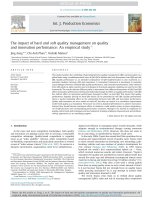

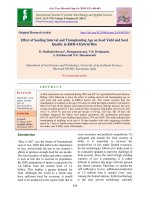
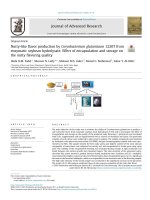
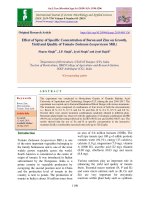
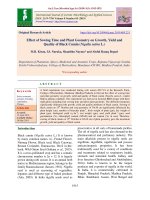
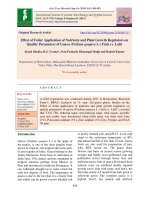
![Effect of fertility levels and stress mitigating chemicals on nutrient uptake, yield and quality of mungbean [Vigna radiata (L.) Wilczek] under loamy sand soil of Rajasthan](https://media.store123doc.com/images/document/2020_01/09/medium_ftp1578562755.jpg)
